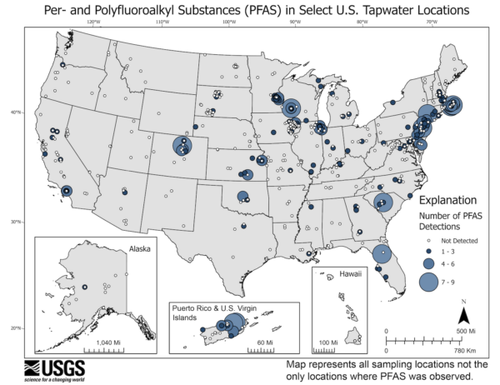Nearly half of the tap water in the United States is estimated to have what are known as “forever chemicals,” also referred to as per- and poly-fluoroalkyl substances (PFAS).

The study by the U.S. Geological Survey tested for the presence of 32 types of PFAS from samples taken from 716 locations—269 private wells and 447 public supply—across the nation from 2016 to 2021.
Based on these samples, USGS researchers determined by modeling that, on average, at least one PFAS is detected in about 45 percent of U.S. tap water.
There are more than 12,000 types of PFAS, which are invisible man-made chemicals, high levels of which have been linked to adverse health issues, including various cancers, reproductive issues, and adverse effects on immune function. But not all of the PFAS types can be detected with current tests.

“USGS scientists tested water collected directly from people’s kitchen sinks across the nation, providing the most comprehensive study to date on PFAS in tap water from both private wells and public supplies,” USGS research hydrologist Kelly Smalling, the study’s lead author, said in a statement on July 5.
“The study estimates that at least one type of PFAS—of those that were monitored—could be present in nearly half of the tap water in the U.S. Furthermore, PFAS concentrations were similar between public supplies and private wells.”
PFAS are colloquially referred to as “forever chemicals” because they don’t easily break down in the human body or the environment, and some of them never fully break down. These substances are known for their resistance to grease, oil, water, and heat, and as such, can be used in a wide range of products, including non-stick cookware, stain- and water-resistant fabrics and carpets, as well as cleaning products, paints, water repellents, and fire-fighting foams.

According to the USGS, the study marks “the first time anyone has tested for and compared PFAS in tap water from both private and government-regulated public water supplies” on a broad scale throughout the United States.
“Those data were used to model and estimate PFAS contamination nationwide. This USGS study can help members of the public to understand their risk of exposure and inform policy and management decisions regarding testing and treatment options for drinking water,” the agency said in a release.
More Risk of PFAS Exposure in Urban Areas
Urban areas are more at risk of PFAS exposure compared to rural areas, with the forever chemicals detected in over 70 percent of urban areas or areas with a known history of PFAS contamination, compared to 8 percent of rural areas.
Researchers observed the exposure in urban areas including around the Great Plains, Great Lakes, Eastern Seaboard, and Central/Southern California regions.
***
Authored by Mimi Nguyen Ly via The Epoch Times, Read more here…
9:33 pm on July 7, 2023


